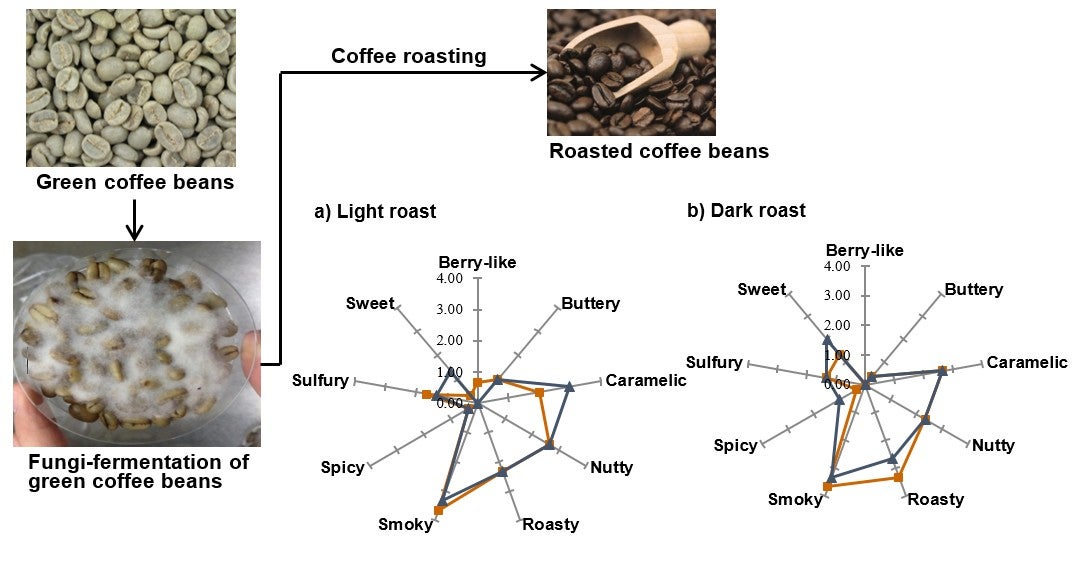No more animal gut-processed coffees!
LIU Shao Quan (Group Leader, Chemistry) () July 18, 201618 Jul 2016. NUS food scientists developed the world’s first coffee fermented the old-fashioned way, with a food grade fungus Rhizopus oligosporus.
A team led by Prof LIU Shao Quan from the NUS Food Science and Technology (FST) Programme devised a process to ferment green coffee beans with R. oligosporus, conventionally used for tempeh (a fermented soy food) production. R. oligosporus fermentation significantly modified the volatile profile and aroma precursors (sugars, amino and phenolic acids) of green coffee beans via biotransformation/metabolic processes. Consequently, these led to significant changes in the volatile profiles of light, medium and dark roasted fermented coffees. Some of the fermentation-induced volatile profile changes were retained after roasting, while modification of aroma precursors influenced coffee aroma formation during roasting. Sensory analysis revealed that R. oligosporus fermentation increased the sweet and caramelic attributes of light roasted coffees and the sweet attribute of dark roasted coffees.
Kopi Luwak and Black Ivory Coffee are two of the world’s most expensive specialty coffees (US$ 1760 per kilogram) produced from “processed” coffee beans derived from the faeces of the animals (civet cats and elephants, respectively). After ingestion, the coffee cherries/beans undergo a combination of fermentation, enzymatic and acidic treatments in the animal’s gut before they are excreted. Besides their high cost, such an unconventional method of processing may not be readily accepted by consumers. Fungi-fermented green coffee beans serve as a cheaper and consumer-friendly alternative to animal-processed coffees as coffee production could easily be scaled up and would be more readily accepted by consumers.
This work provides the platform for further studies exploring the extension of the fermentation process to other fungi, yeast or bacterial species which exhibit desired metabolic characteristics. These microorganisms include Yarrowia lipolytica (the subject of another study by the team), a yeast commonly found in cheese, and lactic acid bacteria. Such studies could generate coffees with different but unique volatile and aroma profiles. In addition, the effects of fungi-, yeast- and bacteria-fermentation of green coffee beans on coffee aroma could be correlated and compared.
Currently, only one patent has reported on the microbial fermentation of green coffee beans and its focus is not on coffee aroma modulation. Other fermentation-related studies mainly focused on the optimisation of the coffee parchment fermentation process intended for mucilage removal during post-harvest processing to promote coffee aroma modulation. The research work by Prof Liu’s team is unique as it explores the fermentation of a substrate (green coffee beans) along the coffee processing chain, an area which has not been considered for coffee aroma modulation.
Despite the superior aroma qualities of wet-processed coffees over dry-processed coffees, wet-processing (traditional fermentation of coffee cherries) is less environmentally friendly as it generates large quantities of polluted water. The devised fermentation process provides an eco-friendly means through solid state fermentation to modulate the coffee aroma of dry-processed coffees.

Figure shows the fermentation of green (unroasted) coffee beans with Rhizopus oligosporus and the impacts of fungi-fermentation on the aroma sensory profiles of a) light and b) dark roasted coffees ( = unfermented coffee beans (control),
= unfermented coffee beans (control),  = fungi-fermented coffee beans). [Image credit: LEE Liang Wei Wilson]
= fungi-fermented coffee beans). [Image credit: LEE Liang Wei Wilson]
References
Lee LW, Cheong MW, Curran P, Yu B, Liu SQ. “Modulation of coffee aroma via the fermentation of green coffee beans with Rhizopus oligosporus: II. Effects of different roast levels”. Food Chemistry. In press. DOI: 10.1016/j.foodchem.2016.05.073.
Lee LW, Cheong MW, Curran P, Yu B, Liu SQ. “Modulation of coffee aroma via the fermentation of green coffee beans with Rhizopus oligosporus: I. Green coffee”. Food Chemistry. In press. DOI: 10.1016/j.foodchem.2016.05.076.
Lee LW, Cheong MW, Curran P, Yu B, Liu SQ. “Coffee fermentation and flavor – An intricate and delicate relationship”. Food Chemistry. 185 (2015) 182-191. DOI: 10.1016/j.foodchem.2015.03.124.


